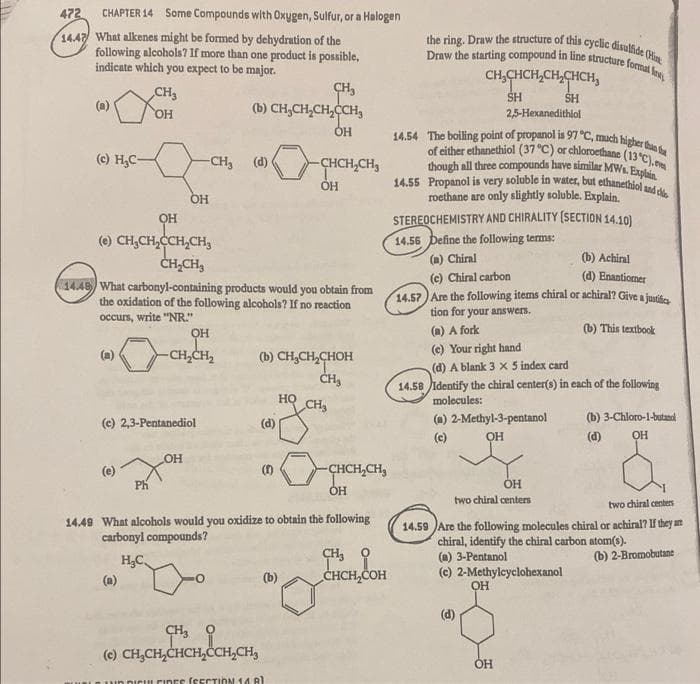14.47 What alkenes might be formed by dehydration of the following alcohols? If more than one product is possible, indicate which you expect to be major. the ring Draw th CH, (b) CH,CH,CH,CCH, CH3 (a) 14.54 The boi of eithe (e) H,C- -CH, (d) -CHCH,CH, though 14.55 Propan roethar OH STEREOCHEMI (e) CH,CH,CCH,CH, 14.56 Define (n) Ch
14.47 What alkenes might be formed by dehydration of the following alcohols? If more than one product is possible, indicate which you expect to be major. the ring Draw th CH, (b) CH,CH,CH,CCH, CH3 (a) 14.54 The boi of eithe (e) H,C- -CH, (d) -CHCH,CH, though 14.55 Propan roethar OH STEREOCHEMI (e) CH,CH,CCH,CH, 14.56 Define (n) Ch
Organic Chemistry
8th Edition
ISBN:9781305580350
Author:William H. Brown, Brent L. Iverson, Eric Anslyn, Christopher S. Foote
Publisher:William H. Brown, Brent L. Iverson, Eric Anslyn, Christopher S. Foote
Chapter8: Haloalkanes, Halogenation, And Radical Reactions
Section: Chapter Questions
Problem 8.11P
Related questions
Question
6

Transcribed Image Text:of either ethanethiol (37 °C) or chloroethane (13 C), ev
though all three compounds have similar MWs. Explain.
14.55 Propanol is very soluble in water, but ethanethiol snd de.
Draw the starting compound in line structure formal les,
the ring. Draw the structure of this cyclic disulide (Hin
14.54 The boiling point of propanol is 97 °C, much higher than t
472
CHAPTER 14 Some Compounds with Oxygen, Sulfur, or a Halogen
1447 What alkenes might be formed by dehydration of the
following alcohols? If more than one product is possible,
indicate which you expect to be major.
CH,CHCH,CH,CHCH,
CH3
SH
2,5-Hexanedithiol
SH
(a)
(b) CH,CH,CH,CCH,
HO,
ÓH
(e) H,C-
-CH, (d)
CHCH,CH,
OH
roethane are only slightly soluble. Explain.
STEREOCHEMISTRY AND CHIRALITY (SECTION 14.10)
(e) CH,CH,CCH,CH3
14.56 Define the following terms:
ČH,CH3
(a) Chiral
(b) Achiral
(c) Chiral carbon
(d) Enantiomer
3449 What carbonyl-containing products would you obtain from
the oxidation of the following alcohols? If no reaction
14.57) Are the following items chiral or achiral? Give a jusife
tion for your answers.
occurs, write "NR."
OH
(a) A fork
(b) This textbook
-CH,CH2
(c) Your right hand
(b) CH,CH,CHOH
ČH,
(d) A blank 3 x 5 index card
14.58 identify the chiral center(s) in each of the following
molecules:
но
CH
(a) 2-Methyl-3-pentanol
OH
(b) 3-Chloro-l-butand
(c) 2,3-Pentanediol
(d)
(c)
(d)
OH
OH
(e)
(1)
CHCH,CH,
OH
OH
two chiral centers
two chiral centers
14.49 What alcohols would you oxidize to obtain the following
carbonyl compounds?
14.59 Are the following molecules chiral or achiral? If they arn
chiral, identify the chiral carbon atom(s).
(a) 3-Pentanol
(e) 2-Methylcyclohexanol
H,C
(b) 2-Bromobutane
(a)
(b)
CHCH,COH
(d)
CH3
(c) CH,CH,CHCH,ÖCH,CH,
OH
URLOI uD DICU FIDES (CECTION 140)
Expert Solution
This question has been solved!
Explore an expertly crafted, step-by-step solution for a thorough understanding of key concepts.
This is a popular solution!
Trending now
This is a popular solution!
Step by step
Solved in 2 steps with 1 images

Knowledge Booster
Learn more about
Need a deep-dive on the concept behind this application? Look no further. Learn more about this topic, chemistry and related others by exploring similar questions and additional content below.Recommended textbooks for you

Organic Chemistry
Chemistry
ISBN:
9781305580350
Author:
William H. Brown, Brent L. Iverson, Eric Anslyn, Christopher S. Foote
Publisher:
Cengage Learning

Introduction to General, Organic and Biochemistry
Chemistry
ISBN:
9781285869759
Author:
Frederick A. Bettelheim, William H. Brown, Mary K. Campbell, Shawn O. Farrell, Omar Torres
Publisher:
Cengage Learning


Organic Chemistry
Chemistry
ISBN:
9781305580350
Author:
William H. Brown, Brent L. Iverson, Eric Anslyn, Christopher S. Foote
Publisher:
Cengage Learning

Introduction to General, Organic and Biochemistry
Chemistry
ISBN:
9781285869759
Author:
Frederick A. Bettelheim, William H. Brown, Mary K. Campbell, Shawn O. Farrell, Omar Torres
Publisher:
Cengage Learning


Chemistry: Principles and Reactions
Chemistry
ISBN:
9781305079373
Author:
William L. Masterton, Cecile N. Hurley
Publisher:
Cengage Learning

Organic And Biological Chemistry
Chemistry
ISBN:
9781305081079
Author:
STOKER, H. Stephen (howard Stephen)
Publisher:
Cengage Learning,

General, Organic, and Biological Chemistry
Chemistry
ISBN:
9781285853918
Author:
H. Stephen Stoker
Publisher:
Cengage Learning